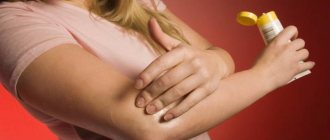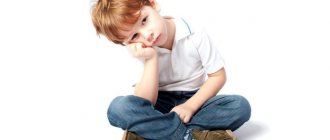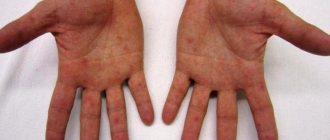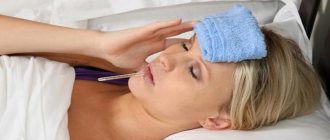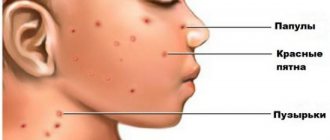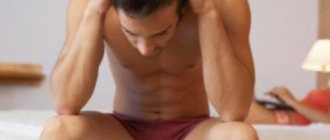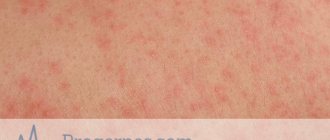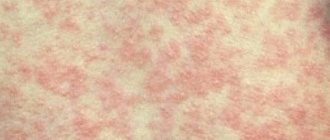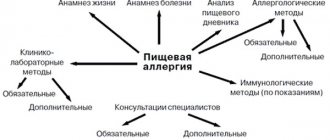Rash on various parts of the body in children of all ages can be called the most common problem with which parents come to the pediatrician. Of course, most often a variety of rashes are observed in babies on the face, stomach, back, in the area where the diaper adheres to the skin, along the entire length of the arms and legs, but in some cases the hands are also affected by such elements. Pimples on the palms of children can have a variety of shapes and types. This depends primarily on the specific cause that provoked the formation of the rash, but how carefully the child’s hygiene is observed also plays a significant role here.
Causes of rashes
As a rule, an experienced pediatrician, based on the type of rashes and the existing clinical picture, can almost accurately determine their disorders and diagnose the child. But in some cases, some examination may be required.
The most common causes of acne on the palms of children's hands include:
- Allergies. Each child, as he develops, actively learns about the world around him, but this process cannot take place without close interaction with it. Therefore, quite often an allergic rash may appear on the baby’s skin as a result of contact with certain substances, for example, pollen and green plants, ordinary house dust, household chemicals, and animal hair. Often, pimples appear on the palms and soles of children as one of the symptoms of a more complex systemic allergic reaction, for example, when eating certain foods or inhaling allergenic particles. In most cases, an allergic rash is accompanied by intense itching with a slight rise in temperature. But in cases of respiratory allergies, symptoms also include a runny nose and sometimes a cough.
- Infectious lesions. The most common infections that cause pimples to appear on the palms of children include chickenpox, rubella, meningococcus and other diseases. The course of the disease in this case will be different and depends directly on the pathogen, as well as on the state of health of the child. With rubella, a small red rash forms on the baby's body, which disappears on its own after 2 to 3 days. Sometimes the disease is accompanied by a slight increase in temperature. With chickenpox, large pathogenic elements of a watery structure are formed on the surface of the body, which gradually dry out and become crusty. This also increases the temperature. With meningococcus, red spots appear on the child's body.
Chickenpox
- Hemorrhagic rash, which is a special vascular disease in which damage and inflammation occur. Most often, small capillaries are the first to be damaged, which is why small, pinpoint hemorrhages begin to appear, very similar to rashes. Gradually, such manifestations begin to merge and can cover significant areas of the skin. The cause of this type of rash is various diseases of the heart and blood vessels, and therefore the child must be hospitalized and kept under medical supervision.
- Parasitic infection. With such infections, rashes also appear on the baby’s palms. Most often, the skin of children is affected by the scabies mite, which moves under the surface of the epidermis, forming passages there, visible externally as small grayish stripes, along which red pimples-papules are formed. As a rule, such elements are accompanied by significant inflammation.
- Measles. This infectious disease is accompanied by large rashes, high fever, severe nausea, complete loss of appetite and severe abdominal pain. Today, thanks to timely vaccinations, this disease is encountered very rarely.
measles
- Scarlet fever. This infectious disease is characterized by all the signs of a severe cold, but at the same time an extensive small rash of a pinpoint nature appears on the body, the size of the elements of which is no larger than semolina.
- Enterovirus infection, in which the rash is localized specifically in the area of the child’s palms. This lesion does not cause any particular discomfort, since it is not accompanied by pain or itching. In some cases, children may develop a slight fever. As these watery pimples increase in size, they darken, gradually becoming brown in color, after which the size of the elements begins to decrease.
- Dermatitis, including diaper dermatitis (in infants). In the summer, a rash on the palms of babies can also occur due to the fact that the surface of the skin sweats intensely. For example, when parents, worried that the baby does not scratch his delicate skin, put special mittens on his hands. In some cases, this may also be accompanied by an infection, including a fungal infection, since sweat is an excellent breeding ground for the development of pathogens. The addition of an infection significantly worsens the situation.
Dyshidrosis
When a child develops a rash on the feet and palms, which manifests itself in the form of specific blisters filled with fluid, this may be a signal that dyshidrosis has developed. This is an infectious disease that affects the skin of the feet and hands.
READ ALSO: Ulcers on the face: how to effectively cure unpleasant pimples
Pediatricians advise monitoring the child’s condition especially closely in the spring and summer. In the hot season, relapses of the disease occur much more often and are associated with blockage of the sebaceous glands. Excessive sweating can cause dyshidrosis in a baby.
Experts identify several factors influencing the development of pathology:
- excessive sweating;
- frequent exciting situations, stress;
- fungal diseases of the dermis;
- heredity;
- diseases of the endocrine system;
- gastrointestinal pathologies;
- allergy.
According to medical statistics, a child susceptible to atopic dermatitis and diathesis is more likely to suffer dyshidrosis.
Dr. Komarovsky believes that the cause of the development of the disease is an allergic reaction of the digestive system, so it is necessary to introduce a new product into the children's diet with caution. If the child is bottle-fed, it is worth replacing the milk formula with another one with a lower concentration.
It is necessary to know the main symptoms of the pathology in order to recognize the disease in time and take measures to eliminate it.
- Dyshidrosis manifests itself in the form of a rash; it most often affects the palms, inner surfaces of the fingers on the upper and lower extremities, and feet.
- At the initial stage, the child notices an uncomfortable tingling sensation in the area of the palms and feet. This leads to the baby starting to scratch the affected skin, resulting in a rash. It begins to cause itching and burning.
- Redness and specific balls and blisters appear on the dermis, which itch and fill with fluid.
- The bubbles are small in size and reach only a few millimeters. They have a transparent tint, but the skin around them becomes red due to constant scratching.
- Over the course of a week, a maximum of 10 days, the rash on the palms and feet goes away. They may open on their own or dry out. In this case, the healing process is accompanied by unpleasant sensations: swelling occurs, erosions appear in place of former blisters, and the dermis becomes painful.
- Finally, the skin begins to peel off. When using special means, the disease is eliminated from this moment in a few days.
READ ALSO: Watery blisters on the fingers: small, treatment, how to treat
Parents should remember that true dyshidrosis is distinguished by the absence of new blisters. After self-opening of the rash, no new manifestations should appear. The baby may develop dry dyshidrosis, which is characterized by the absence of the stage of bubbles with liquid, and the peeling stage immediately begins.
Treatment of pathology is not difficult if you consult a specialist in time.
Pediatricians often prescribe a specific therapeutic regimen consisting of antihistamine medications: Suprastin, Fenistil, Diazolin. Sorbent drugs (Activated carbon, Smecta, Enterosgel, Enterosorb) and sedatives that can be used in childhood are included: for example, Valerian. Sometimes the doctor prescribes additional medications or vitamin complexes for calcium levels.
For external use, antimicrobial drugs with a drying effect are prescribed: Brilliant Green solution, Fukortsin. Also, products that can quickly dry out rashes include: Sudocrem, Furacilin solution, zinc ointment. A prerequisite is the use of corticosteroid medications: Dermovate, Sinaflan, Lorinden, Flucinar. It is not recommended to use these drugs directly; a small amount of ointment should be added to baby cream and applied in moderation to the skin.
READ ALSO: Rash on the shoulders and forearms in the form of acne: photos and causes
Treatment of acne on children's palms
If the baby has no other symptoms other than the rash, then a number of measures can be taken to eliminate such manifestations. The optimal means of therapy in this case can be considered decoctions and water infusions of medicinal herbs, as well as special children's creams that do not contain aggressive chemical components.
Decoctions and infusions of herbs such as medicinal chamomile, calendula flowers, string, must be added to the bathing water for each procedure. After bathing, the baby's skin should be gently blotted with a soft cotton towel without wiping, and then the entire surface of the body should be lubricated with a light baby cream. Such measures will also help eliminate itching and other discomfort, if any.
It is important to avoid strong physical impact on injured children's skin, as this can significantly worsen the situation. Therefore, it is forbidden to wipe the skin and rub the cream until absorbed. All movements should be soft and careful.
For children over 3 years old, the doctor may prescribe antihistamines in tablet form or in the form of ointments and creams. Most often, for allergic manifestations, dermatitis, urticaria, prickly heat, and other types of rashes, the doctor prescribes medications for the baby such as Fenistil, Suprastin, Loratadine, Tavegil. As well as external products in cream or gel form, such as Solcoseryl or Sinaflan.
It is important to remember that antihistamines should not be given to children on their own. Only a doctor can assess the need for the use of such drugs and their form, select the correct drug in each specific case and calculate the dosage so that the therapy does not have adverse consequences.
If the appearance of rashes is accompanied by a significant deterioration in the child’s condition or symptoms of general intoxication, then you should immediately call a doctor or take the baby to the hospital yourself.
In some cases, it may be necessary to use specialized products to treat acne on the palms and soles of children. For example, when such formations are provoked by any infection or the development of other pathogenic microorganisms. In this case, the child may be prescribed special ointments that contain antibiotics against a specific pathogen. It is impossible to choose the right means of this kind yourself, as well as to assess the adequacy and necessity of their use, so you should not try to treat the baby yourself.
How to treat blistering rash on feet and palms
First, the doctor finds out the causes of the rash in order to make an accurate diagnosis and prescribe targeted treatment. In some situations, such as allergies or viral diseases, specific treatment is not required.
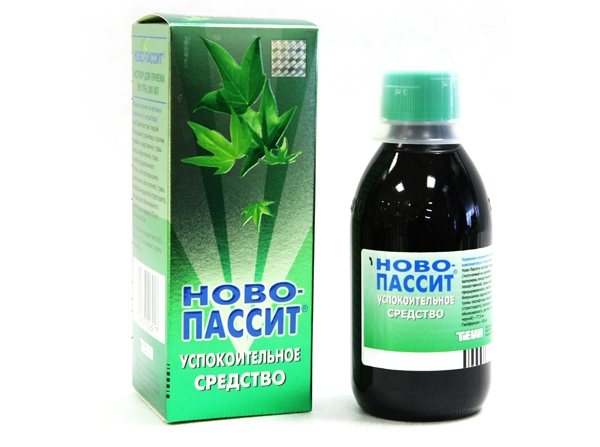
- infectious etiology of the rash, then the bacteria that caused it are determined, and the doctor must prescribe antibiotics;
- allergies of various origins, the allergen is first identified, and then the doctor prescribes treatment to eliminate it, always with a course of antihistamines;
- vascular diseases, then the child is referred for consultation and further treatment with a hematologist;
- scabies, which can be seen by paired spots near the vesicle - the entrance and exit of the mite, then the child is sent to a dermatologist;
- mycotic infection, then treatment is aimed at getting rid of the fungal infection;
- affected by the herpes virus, its treatment is difficult, long, with frequent relapses;
- the onset of eczema, it is treated by a dermatologist. The disease is often allergic and infectious in nature. Treatment takes a long time, with frequent exacerbations. Accompanied by neuroses, insomnia;
- the onset of psoriasis, it is treated by a dermatologist. This is a disease from the group of dermatoses with an unknown etiology.
Even minor rashes should be seen by a doctor. Only he is able to identify their cause.
Prevention of rashes on the palms of children
We must not forget that most cases of rashes on a child’s skin can be prevented by following fairly simple rules. It is very important to provide complete care for the baby, which includes daily bathing and treating the skin with powders and creams. We should not forget that even a baby who does not yet know how to sit and crawl is constantly in contact with the outside world, with the air, with objects. He grabs clothes, diapers, toys, adults, pacifiers, bottles with his hands. Therefore, it is necessary to wash his hands several times a day with baby soap or at least wipe them with special wet wipes for children (if washing is not possible).
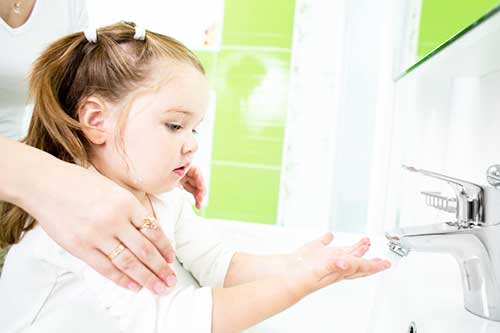
It is important to protect your child from synthetic things. Therefore, when choosing clothes for your baby, you should give preference to natural fabrics, preferably cotton with a minimal content of dyes.

It is necessary and correct to wash children's clothes. You should not pour the usual powder into the washing machine, as well as load baby clothes together with adult clothes. To wash children's clothes, you need to use special soap-based powders or liquid soap without dyes and artificial additives, adding a special fabric softener for babies to the last rinse to soften the fabrics and eliminate detergent residues.
It is also necessary to take care of cleaning the children's room, as well as its ventilation. Such procedures should be carried out twice a day.
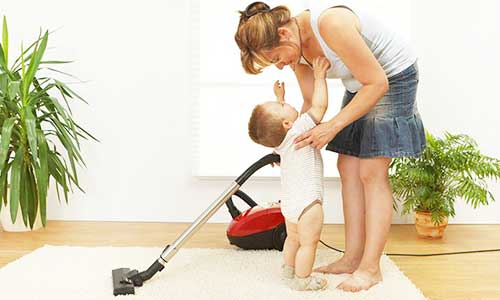
There is no need to wrap the baby up. It should be remembered that overheating is no less dangerous for a baby than hypothermia. The skin of young children does not yet know how to independently regulate temperature and cope with its changes, and the baby himself cannot tell his parents that he is hot. As a result of overheating, a large amount of sweat is released, which leads to the formation of rashes (heat rash).
If the child is breastfed, then the mother needs to reconsider her diet and remove from it foods that can trigger allergies. When breastfeeding, you need to follow a diet, and introduce new foods into the baby’s menu gradually, observing the body’s reaction. The same applies to older children. In most cases, the appearance of a rash is associated precisely with the consumption of any products that cause an inadequate reaction in the child’s body.
It is important to remember that children's skin is much thinner, more delicate and particularly sensitive, so rashes on it are not at all uncommon, because many factors can provoke the appearance of pathogenic elements. However, it is impossible to make a diagnosis on your own, much less prescribe therapy. This should only be done by a qualified doctor.
